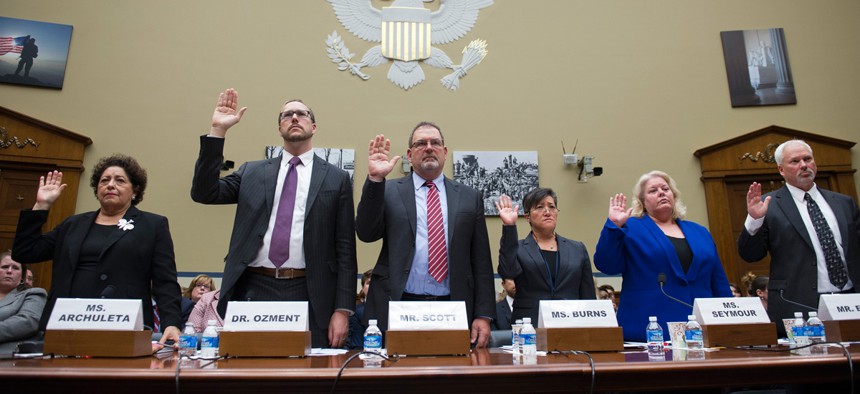After Dodging the Bullet that Hit OPM, Interior ‘Owns’ Up to Cyber Problem

Third from left, Sylvia Burns, Interior CIO, testifies before the House Oversight and Government Reform committee's hearing on the Office of Personnel Management data breach. Cliff Owen/AP
Department CIO Sylvia Burns was horrified to learn another agency's database was hacked inside her IT facility.
Sometimes, fear is the best motivator. At the Interior Department, this was the case when hackers stole millions of federal employee records from an Office of Personnel Management database stored inside one of Interior's data centers. The assailants left Interior's data unscathed.
But point taken, Interior Chief Information Officer Sylvia Burns said Wednesday afternoon.
The incident, part of a historic hack against the U.S. government, prompted the department to expedite a goal of eliminating wimpy passwords as the only safeguard when signing in to agency systems.
The intruders, suspected Chinese spies, used a stolen password from an OPM contractor to copy OPM's database, according to federal officials. From OPM's network, the bad guys then scampered across the entire Interior facility's IT environment, Burns said. All other data, however, was not compromised, she said.
"When I, as a CIO for the department, learned of the intrusion, it was horrifying to me and since that time, my team and I have been on high alert working probably seven days a week, long hours to take our lessons learned and do a mitigation plan around it," Burns said.
Still, Burns clearly has her work cut out for her. Results of an information security audit presented to lawmakers Wednesday laid out thousands of security vulnerabilities in Interior’s public websites.
The White House in 2004 first mandated all federal system logins require the use of both a password and a smart card, a process known as two-factor authentication.
"That's an important control that's needed. We were already working on it," Burns told members of the House Oversight and Government Reform Committee on Wednesday. "We were making slow progress. When the incident happened, it just created a different lens on looking at the need, and I think it made it crystal clear to everybody why it was so critical that we achieve two-factor authentication."
The attackers stole the OPM password from a "privileged user," an individual granted wide access to a system's configurations and information, Burns said. No government smart card, or "personal identity verification," card was necessary.
"That's why we were aggressive about moving to getting all of our privileged users using their PIV cards to authenticate to their systems," Burns said.
By June 26, all privileged users needed smart cards to sign on to Interior systems. Orders from up above gave the department an extra push.
On June 12, the White House told all agencies to accelerate the activation of two-step identification and lay down other data protections, as part of a 30-day cybersecurity sprint.
Today, at least 75 percent of regular Interior computer users also log in with smart cards and passwords, Burns said.
The hearing was one of half a dozen held in response to the OPM attack now known to have affected 21.5 million federal personnel, individuals vetted for handling U.S. secrets, and their family members.
Under pressure from lawmakers on both sides of the aisle, OPM Director Katherine Archuleta resigned last week, without ever acknowledging accountability.
Burns on Wednesday took responsibility for her department’s information security weaknesses.
Separate from the OPM incident, an Interior inspector general recently identified 3,000 "critical" and "high-risk" vulnerabilities in the department's publicly-facing websites. They have since been fixed, but other security holes likely lay unknown, waiting to be discovered by intruders.
The number of vulnerabilities "could potentially" be higher because the department does not perform scans of all systems, Deputy IG Mary Kendall said at the hearing.
"We have to all own this problem and it will take all of us to fix the problem, “Burns said of the cybersecurity dilemma in general, across her department's distributed bureaus and offices. “And everybody has been taking it seriously, so I’m very gratified by that.”






